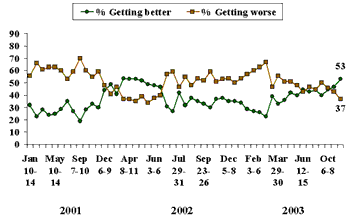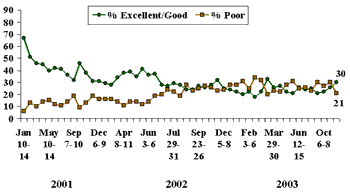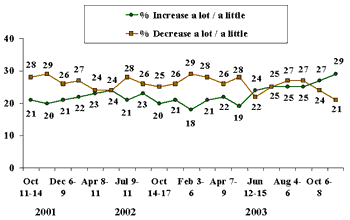GALLUP NEWS SERVICE
Consumer perceptions of the economy changed dramatically between late October and early November, according to a new Gallup Poll, conducted Nov. 3-5. Consumer optimism is now at its highest level in more than 18 months. Consumer spending intentions are more positive than they have been at any point since 9/11. Add this attitudinal economic data to the surge in economic growth during the third quarter and the new job growth reported by the Labor Department and there is every reason for retailers to be extremely optimistic about consumer spending during the upcoming holidays.
Consumers Are Much More Optimistic About Economic Direction
According to the early November poll, many more consumers now say economic conditions are "getting better" (53%) than say they are getting worse (37%) -- a difference of +16 percentage points. Although there was also a net positive reading for this question in late October, the difference for that month between the "getting better" (47%) and "getting worse" (43%) responses was only +4 percentage points. This means consumers are significantly more optimistic about the future prospects for the U.S. economy than they were in October, and represents a complete turnaround from September, when the difference was –10 percentage points.
More importantly, this is the first time since May 2002 that the percentage of Americans saying they think economic conditions are getting better rather than worse has surpassed the 50% mark. In fact, in the three years prior to this month, with the exception of March to May 2002, no more than half of the American public had said economic conditions were getting better.
| Economic Conditions Getting Better or Getting Worse? |
 |
A Substantial Improvement in Current Economic Assessments
In sharp contrast to October, more consumers now say current economic conditions are "good" or "excellent" (30%) than say they are "poor" (21%) -- a difference of +9 percentage points. Further, these early November ratings represent a complete reversal from September, when this difference was –9 percentage points. The net ratings for November are the best since March, just after the beginning of the war in Iraq (+13 percentage points), and are about the same as they were late last November (+9).
| Rating of Current Economic Conditions |
 |
More Consumers Plan to Spend More
More consumers (29%) say they plan to spend more over the next six months than say they plan to spend less (21%). This positive difference of 8 percentage points contrasts sharply with the –5 percentage-point difference of October 2002 and the –9 of November 2001. Current consumer spending intentions are now at their most positive level since Gallup began tracking consumer spending intentions in this way during October 2001 -- following the events of Sept. 11.
| In the Next Six Months, Will Your Overall Level of Spending Increase or Decrease? |
 |
A Potential Spending Spree?
Gallup's attitudinal economic data show consumers becoming much more optimistic in early November. Importantly, even as overall consumer optimism has improved, higher income consumers remain much more optimistic than their less well-off counterparts.
Thirty-eight percent of consumers making $75,000 or more a year rate current economic conditions as good or excellent, while only 18% rate them as poor -- a difference of +20 percentage points. In sharp contrast, only about one in four consumers with annual incomes of less than $50,000 rate current economic conditions as excellent or good, while just about the same number rates them as poor. Similarly, two out of three consumers with annual incomes of $75,000 or more say economic conditions are getting better, while fewer than half of consumers with annual incomes of less than $50,000 say this.
Not surprisingly, as consumers' optimism has increased, so have their spending plans. And, like their optimism, consumers' spending plans are more positive among consumers having higher incomes. For example, 34% of consumers making $75,000 or more annually say they plan to increase their spending in the next six months, while only 19% say they plan to decrease spending, for a difference of +15 percentage points -- a much larger positive difference than for any other income group.
In sum, all indications are that consumers will be in a spending mood during the holidays just ahead. The spending spree is likely to be led by those with higher incomes. And, it might end up being the best holiday season for the nation's retailers in three years.
Survey Methods
Results are based on telephone interviews with 1,007 national adults, aged 18 and older, conducted Nov. 3-5, 2003. For results based on this sample, one can say with 95% confidence that the margin of sampling error is ±3 percentage points. In addition to sampling error, question wording and practical difficulties in conducting surveys can introduce error or bias into the findings of public opinion polls.

